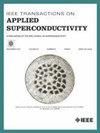Elliptic Aperture CCT Coils for HTS Dipole Magnets
IF 1.8
3区 物理与天体物理
Q3 ENGINEERING, ELECTRICAL & ELECTRONIC
引用次数: 0
Abstract
High-temperature REBa用于高温超导偶极磁体的椭圆孔径CCT线圈
高温REBa$_{2}$Cu$_{3}$O$ {7-x}$ (REBCO)超导体是将加速器磁体的磁场增加到超过Nb$_{3}$Sn的15-16T实际极限的途径。采用CORC几何形状的REBCO电缆非常适合这种应用,可以设计具有导体换位的低电感磁体。然而,在加速器磁体典型的紧导体弯曲半径线圈中使用CORC仍然是一个关键挑战,导体开发和线圈设计前沿的研究都在寻求解决这个问题。在这项工作中,我们探讨了圆形和椭圆孔径斜余弦(CCT)线圈之间的权衡,当导体的最小弯曲半径是一个关键考虑因素时,得出结论,孔径椭圆度是优化磁高效CORC偶极磁体的一个重要的自由参数。特别是,我们表明椭圆孔设计可以实现更小孔径的高温超导线圈,这对于lts -高温超导混合磁体以及更普遍的非圆形磁体孔径的加速器应用来说是一个重要的结果。为此,我们在美国磁体开发计划(US- mdp)中提出了一种针对混合测试进行优化的椭圆孔径偶极子设计,并分享了一个原型线圈的77 K测试结果,该结果首次实验证实了该优点。
本文章由计算机程序翻译,如有差异,请以英文原文为准。
求助全文
约1分钟内获得全文
求助全文
来源期刊

IEEE Transactions on Applied Superconductivity
工程技术-工程:电子与电气
CiteScore
3.50
自引率
33.30%
发文量
650
审稿时长
2.3 months
期刊介绍:
IEEE Transactions on Applied Superconductivity (TAS) contains articles on the applications of superconductivity and other relevant technology. Electronic applications include analog and digital circuits employing thin films and active devices such as Josephson junctions. Large scale applications include magnets for power applications such as motors and generators, for magnetic resonance, for accelerators, and cable applications such as power transmission.
 求助内容:
求助内容: 应助结果提醒方式:
应助结果提醒方式:


